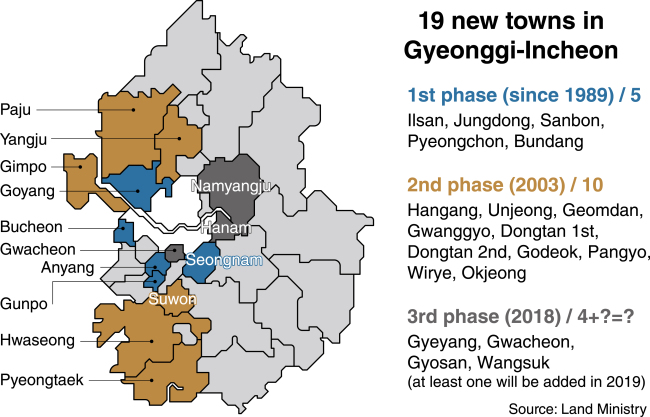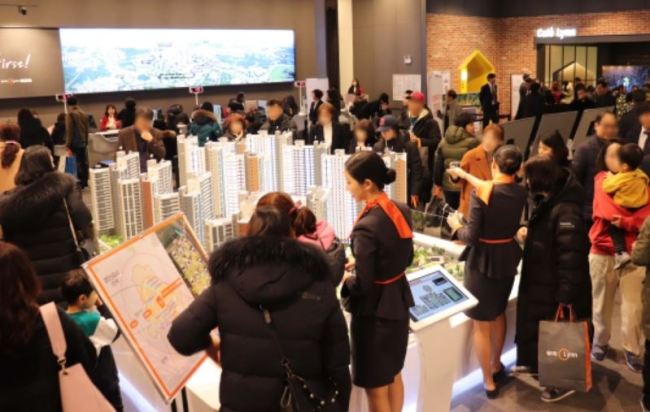[News Focus] Gyeonggi new towns create en masse commuters to Seoul for 30 years
By Kim Yon-sePublished : April 7, 2019 - 16:05
SEJONG -- It has been three decades since South Korea embarked on the construction of “new residential towns” in satellite cities, with the aim of dispersing Seoul residents to a certain extent and elevating housing supply.
For three years since April 1989, the former Roh Tae-woo government fostered residential towns in five districts -- Ilsan, Jungdong, Sanbon, Pyeongchon and Bundang. The five, surrounding Seoul, are dubbed the nation’s first-phase new towns.
For three years since April 1989, the former Roh Tae-woo government fostered residential towns in five districts -- Ilsan, Jungdong, Sanbon, Pyeongchon and Bundang. The five, surrounding Seoul, are dubbed the nation’s first-phase new towns.

More exactly, Ilsan and Bundang are “gus” (or wards) of Goyang and Seongnam cities respectively, while Jungdong, Sanbon and Pyeongchon are “dongs” (or districts in wards) of Bucheon, Gunpo and Anyang cities.
Jungdong new town is based on apartments built in Sang-dong and Jung-dong in Bucheon City, and Insan new town refers to those built in Western Ilsan-gu and Eastern Ilsan-gu in Goyang City. Jungdong and Ilsan are located in the west and northwest of Seoul.
Pyeongchon new town involves areas such as Pyeongchon-dong, Hogye-dong, Bisan-dong and Gwanyang-dong. Sanbon new town comprises apartments in Geumjeong-dong and Sanbon-dong in Gunpo City, while Pyeongchon, Sanbon and Bundang are located in the south of Seoul.
These days, a large portion of citizens regard the five as de facto cities in consideration of their high population density and public awareness.
Though the five brought the effect of reducing the population of Seoul and spiraling property prices, some of them have been stigmatized as “bed towns” that lack self-sufficiency.
Construction of the second-phase new towns was initiated by the Roh Moo-hyun administration in 2003.
The towns were dubbed Hangang in Gimpo City; Unjeong in Paju City; Geomdan in Incheon City; Gwanggyo in Suwon-Yongin cities; Dongtan 1st in Hwaseong City; Dongtan 2nd in Hwaseong City; Godeok in Pyeongtaek City; Pangyo in Seongnam City; Wirye in Songpa-Hanam-Seongnam cities; and Okjeong-Hoecheon in Yangju City.
While Wirye and Pangyo new towns enjoyed high popularity among many Seoul citizens, who wanted to relocate their homes, many of the 10 new towns had to suffer from lack of demand with new apartment complexes remaining “unsold” for quite a while.
Discontent among commuters to Seoul in some of the towns is yet to resolved amid insufficient public transportation infrastructure and relatively far driving distances.
A resident in Jungdong new town complained that “the government and builders have fostered apartment complexes in the Seoul metropolitan area en masse without constructing sufficient outer roads.”
More significantly, the nation has not been successful in easing the spike in Seoul apartment prices despite construction of the first and second new towns for decades.
On Dec. 19, 2018, the government unveiled the list of four districts, where the third phase of residential new towns will be created. They are Gyeyang-gu in Incheon City; Gwacheon-dong in Gwacheon City; Gyosan-dong in Hanam City; and Wangsuk-stream area in Namyangju City.
Wangsuk new town topped the list in the state-planned number of apartment units of 66,000, followed by Gyosan with 32,000, Gyeyang with 17,000 and Gwacheon with 7,000.
Further, the Ministry of Land, Infrastructure and Transport is moving to additionally designate one to three more sites as part of the third-phase project, which will be linked to the combined number of Gyeonggi-Incheon new towns at 20 or more, from the current 19 between 1989 and 2018.
Its unveiling following the December announcement will likely be as early as this June though officials have not clarified the timing.
Potential candidates have already been mentioned in the market. Among they are Samsong-dong and Wonheung-dong in Goyang City; Gwangmyeong-dong in Gwangmyeong; and Gwarim-dong in Siheung City.

According to the Ministry of Interior and Safety, the number of residents in Gyeonggi Province surged by 15.8 percent over the past decade to reach 13.11 million as of March 2019, compared to 11.32 million in March 2009.
In contrast, Seoul saw its population drop by 4.4 percent over the corresponding period to stay at 9.77 million.
A real estate agent in Sejong Self-Governing City said that the lingering problem surrounding property prices in Seoul -- despite the dispersal of residents in the capital -- lies in the workplace-imbalance, under which “about 50 percent of Korea’s 1,000 major private enterprises (and 75 percent of 100 major) by sales are headquartered in Seoul.”
Many online commenters share the view that the government needs to promote relocation of headquarters of private businesses, apart from those for state-funded agencies.
A commenter raised the necessity of dividing Gyeonggi into two administrative provinces, citing its record population.
“Amid continuous creation of bed towns in Gyeonggi, apartments in Seoul will continue to lay golden eggs,” a netizen said. “Relocation of universities to provincial districts is recommendable, as long as housing prices are concerned.”
By Kim Yon-se (kys@heraldcorp.com)



![[Herald Interview] 'Amid aging population, Korea to invite more young professionals from overseas'](http://res.heraldm.com/phpwas/restmb_idxmake.php?idx=644&simg=/content/image/2024/04/24/20240424050844_0.jpg&u=20240424200058)












![[KH Explains] Korean shipbuilding stocks rally: Real growth or bubble?](http://res.heraldm.com/phpwas/restmb_idxmake.php?idx=652&simg=/content/image/2024/04/25/20240425050656_0.jpg&u=)

